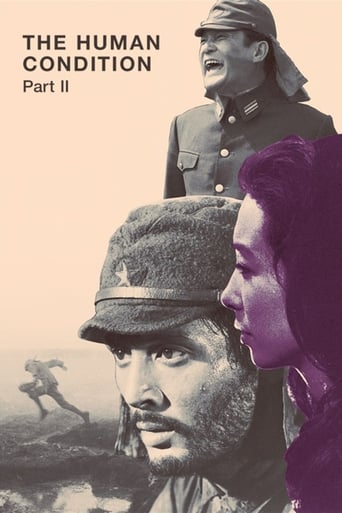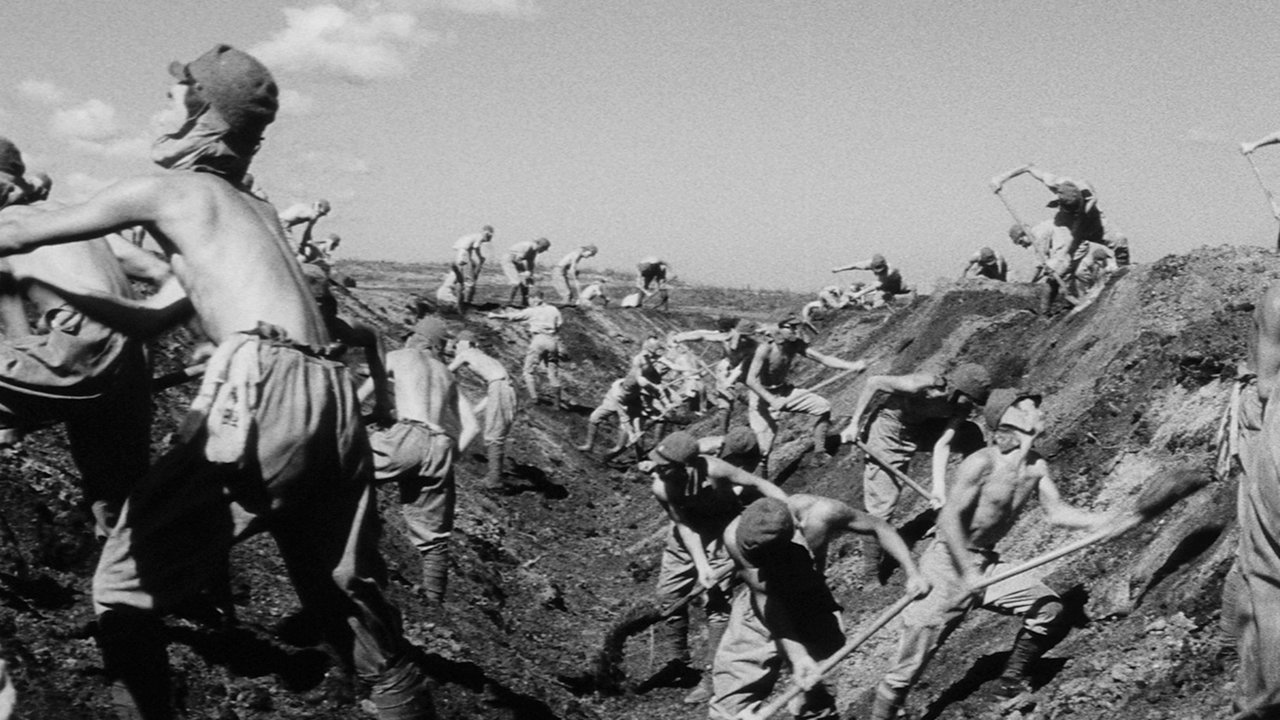mevmijaumau
The Human Condition (Ningen no jôken) is a 9,5 hour long epic film trilogy directed by Masaki Kobayashi, based on the six volume novel by Junpei Gomikawa. The trilogy stays true to the novel's composition by being divided into six parts, meaning that each of the three installments are split in two parts, in between which are intermissions. Both parts in the first film begin with the same opening credits sequence, showing us some stoneworks portraying dramatic imagery (the similar intro opens all three films). The three movies, each long 3 hours or more, are called No Greater Love, Road to Eternity and A Soldier's Prayer.So far, I'm two thirds into the trilogy and I find Road to Eternity to be lesser than the first film. RtE follows Kaji as a conscript in Japanese military, first concentrating on his experiences during basic training and later shifting to a battlefield. Now, RtE surpasses NGL on a technical scale; there's no sugar-coating of historical events, no Japanese actors trying to pass up as the Chinese (except in one, scarcely important scene) and no melodramatic orchestral music (instead, RtE sports a militaristic, more quiet soundtrack). However, this entry in the trilogy reaches the point when the entire story starts to get really repetitive and you really get the feeling that you've seen Kaji humiliated and beaten up enough times to start getting tired by the film. There are a LOT of forgettable scenes of little importance which do nothing but prolong the runtime in order to provide artificial oomph. This is also true for NGL to some extent, but in the first movie I found the storyline to be way more absorbing. Most of RtE occurs in darkly lit, claustrophobic barracks and tight areas where you can't even differentiate the characters. This change of location just isn't as interesting to me as the camp in NGL, but it makes sense because Kaji's humanism is completely beaten to the ground in this movie, and the sudden set change reflects that.Even though I think that the second movie is less captivating than the first, it still has two powerful things going for it; first, the cinematography, once again, is absolutely amazing and Kobayashi once more shows his talent in crafting widescreen, chiaroscuro shots. Second, the final 30 minutes on the battlefield are brilliantly shot, acted out, put together and manage to be brutal, tense and contemplative all in one. Obviously the actors playing the Soviet soldiers are Japanese so Kobayashi doesn't show their faces, but I think that little detail actually adds to the movie's symbolic value.By the way, the reason why this is the shortest entry in the trilogy is probably because it was cut. The scene where Michiko strips naked for Kaji was censored by a government comitee.7,5/10I should also mention that this movie heavily inspired Stanley Kubrick's Full Metal Jacket (which I think is a much better film by the way). The novel upon which FMJ is based on, The Short-Timers, was written after Kobayashi's trilogy. Here are the similarities between the two films:1) Both films are divided into two parts. First part is basic training, the second is set on a battlefield.2) The main characters in both films (Kaji, Joker) are recruits who oppose the brutal military conditioning, but in the same time are able to adapt to their surroundings without losing their ideals. Both Kaji and Joker have feuds with their respective drill instructors, however the DIs also respect them to a point for showing their guts.3) Both Kaji and Joker befriend a fellow recruit (Shinjo, Cowboy). They have discussions while cleaning the toilet.4) Both groups have a weak, slow recruit who isn't able to adapt to given orders. In RtE it's pvt. Obara (who strangely looks like pvt. Baldrick from Blackadder Goes Forth), in FMJ it's pvt. Pyle. In both films, they do something stupid which makes the DI hate them (throwing a cigarette in the water barrel in RtE, hiding a jelly doughnut in FMJ).5) Kaji/Joker takes Obara/Pyle under his wing, but everyone else hates the weak recruit. This character is constantly humiliated in both films. In FMJ, he's forced to act like a baby, while in RtE he has to behave like a geisha (sgt. Hartman also likes to compare his men with ladies).6) Both characters get fed up and commit suicide on a toilet seat by pointing the rifle upwards and shooting (Pyle out of insanity, Obara out of shame). The music in this scene is very similar in both Kubrick's and Kobayashi's film. Pyle's suicide isn't committed on the toilet in The Short Timers, but instead in front of the other members of the group.7) Some training sequences and punishments are very similar, if not identical.Here's the album with comparison images: http://imgur.com/a/XeNP5
OttoVonB
Part II of Masaki Kobayashi's "Human Condition" follows the noble Kaji (Tatsuya Nakadai), now forced into military service, as he tries to hold on to his conscience despite increasingly absurd circumstances.If Part I was a POW drama with a love story sub-plot, influencing many that followed it, then Part II is one of the best and rawest of the original boot-camp films, planting seeds for, in particular, "Full Metal Jacket". In fact, Kaji's training with the Imperial Army makes US Boot Camp look like daycare, uninclined as director Kobayashi is to pull punches when it comes to the ritual sadism of the Japanese military, which he personally endured in real life. The film bravely confronts Kaji's attitude, an almost holier-than-thou morality than annoys bullying veterans. This forces Kaji to deeply transform as a character and as a human being, from preppy moralist to actual, worn hero, a transition Nakadai pulls off with tremendous effect and efficiency.But back to the bigger picture. Like Kubrick's similar – and, one should point out, lesser – film of the same genre, this is two pictures in one: a boot-camp film about the dehumanization of the military, and a war film. The first two thirds are all intensive training, with bullying veterans and hapless recruits. Here Kaji faces an interesting contradiction: he rejects the war with all his heart, yet he has it in him to be a perfect warrior. There is the inevitable inept recruit pushed to the brink subplot, but it is handled with more humanity and sense of absurdity than most other similar films could dream of.Finally, the film takes us to the front, where all the bluster and empty honor fades in front of a line of charging enemy tanks, a startlingly effective battle scene that separates the men from the boys, though not in ways they had anticipated. Kobayashi's film rejects the traditional "bridge syndrome" typical of middle installments in film trilogies, and gives us the perfect Part II: a self-contained enough story with enough substance and depth to stand on its own, while drawing from its predecessor and opening up interesting possibilities for the finale.Roll on part III.
Claudio Carvalho
Kaji is sent to the Japanese army labeled of Red and is mistreated by the vets. Along his assignment, Kaji witnesses cruelties in the army; he revolts against the abusive treatment spent to the recruit Obara that commits suicide; he also sees his friend Shinjô Ittôhei defecting to the Russian border; and he ends in the front to fight a lost battle against the Soviet tanks division. "The Human Condition – Parts III & IV" is the first sequel of the anti- war masterpiece by Masaki Kobayashi. The story is impressively realistic and magnificently shot with top-notch camera work, giving the sensation of a documentary. But maybe the most impressive is to see the treatment of the Japanese military with their soldiers. If they treated their own compatriots with such brutality, imagine how the enemies would be treated? My vote is ten.Title (Brazil): Not Available
Polaris_DiB
Or, as with the Lord of the Rings books, part III and IV.Here is featured Kaji's military exploits in boot camp and the Manchurian front. As predictable based on the previous movie, Kaji beats heads with the military and comes out worse for wear from it. The better side of these movies is Kaji's critical thinking and intelligence, but this time around he makes some pretty foolish decisions considering that at this point he is not only without power, but completely suspect. Nevertheless, our headstrong hero manages to protect his everyman principles and save a few trainees from being severely beaten at boot-camp--this time largely by taking the beatings himself. I have to admit, there's only so many times you can watch Kaji getting beaten up before you begin to think that it's all getting pretty ridiculous. Not a whole lot was gained by his actions this time around for the amount of pain and humiliation he endures.A particular subplot of note involves the mentally unstable Obara, a Japanese Pvt Pyle from thirty years before Kubrick's Full Metal Jacket, who meets a very similar fate. In fact, it's pretty certain that Kubrick saw this movie, though the effort may have been returned considering that some of the later battle scenes in this movie seem right out of Paths of Glory, which was made three years before this one. Of course, my Kubrick comparisons may simply have something to do with Kobayashi's widescreen compositions, where every amount of positive and negative space is used to careful, calculating effect.Meanwhile, the prolonged battle sequences at the end of Part IV are something unto themselves. After the long and political journey we've taken through Japanese nationalism and its corruption, Kobayashi doesn't shy in the least bit from showing dismembered limbs, blown up bodies, and madness taking away men's lives. And it's interesting to see that Kaji, no longer in a place to stand up to authority, no longer has the ability to control his own madness.These two parts are slightly looser than the first third of The Human Condition. A long sequence involving a hospital stay sticks out like a piece from a different puzzle especially, in what is for the most part a carefully crafted novelistic film. Not a whole lot is added by Kaji's experiences in the hospital except for a simple set-up of a later relationship and the death of a corrupt PFC. Of the entire 7hrs30mins the complete movie has run so far, I do believe a fair bit of Part III could have been cut out.So now we are left with Kaji's newfound guilt and battle experience as he becomes a POW to the Russians. Considering how ineffective he was at creating positive change in this second third as opposed to the first third, it's not looking like he's got a whole lot of ground left to stand on, and now he has to seriously question himself as well.--PolarisDiB


 AD
AD


